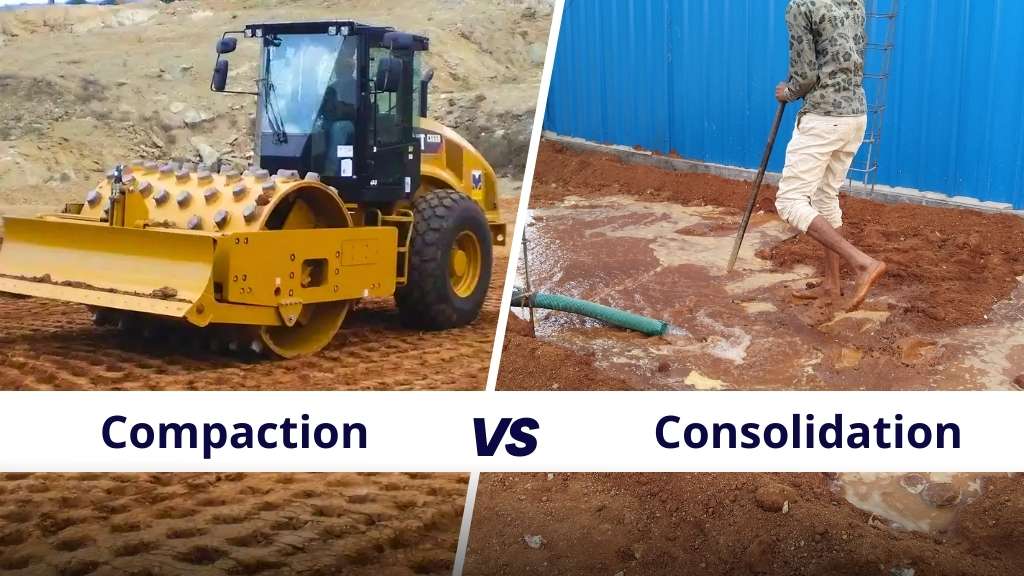Property Geek
We provide the actual and accurate information with unbiased user driven reviews to our viewers, to help them see the best and find the best!
View posts
In construction and geotechnical engineering, soil behavior plays a critical role in ensuring a structure’s stability and strength. However, terms like compaction and consolidation are often misunderstood or used interchangeably, leading to confusion.
While both processes improve soil density, they occur under different conditions and for distinct reasons. Understanding the key differences between compaction and consolidation of soil is essential for effective site preparation and long-term structural performance.
In this article, we’ll break down these concepts, highlighting their processes, purposes, and major differences.
Compaction refers to the process of mechanically reducing the volume of soil by applying external forces. It is typically done to improve the engineering properties of soil, such as increasing its strength, reducing its permeability, and minimizing settlement. Compaction is commonly performed in construction projects where the soil is used as a foundation material, such as building foundations, road construction, and earth embankments.
During compaction, heavy machineries, such as compactors or rollers, applies repeated impacts or vibrations to the soil, which rearranges its particles and removes air voids. This compaction process increases the soil density and decreases its porosity, making it more stable and less susceptible to settlement or deformation.
Consolidation, on the other hand, refers to the gradual process of soil settlement that occurs due to the expulsion of water from the soil mass under sustained load. When a load is applied to a saturated or partially saturated soil, the water in the soil’s pores is squeezed out, and the soil particles come closer together. This process continues until the excess pore water is fully dissipated, and the soil reaches a state of equilibrium.
Consolidation is a time-dependent process and can take a significant amount of time to complete, depending on the characteristics of the soil and the applied load. As the soil undergoes consolidation, it may experience settlement, which can cause structures built on or within the soil to sink or experience uneven deformation. Proper consideration of consolidation effects is crucial in geotechnical engineering to ensure the long-term stability of structures.
Here’s a table highlighting 20 points of difference between compaction and consolidation:
|
Points of Difference |
Compaction |
Consolidation |
|
Definition |
Process of mechanically densifying soil or other material |
Process of gradual settlement of a saturated soil |
|
Purpose |
Increase soil density and reduce voids |
Reduce settlement and improve soil stability |
|
Mechanism |
Application of external force to soil or material |
Natural process is driven by self-weight and water drainage |
|
Time Frame |
Quick process |
Gradual process |
|
Duration |
Short-term effect |
Long-term effect |
|
Type of Material |
Granular and cohesive soils |
Mainly cohesive soils |
|
Saturation |
Dry or partially saturated soil |
Fully saturated soil |
|
Volume Change |
Volume reduction due to densification |
Volume reduction due to drainage and soil compression |
|
Water Content |
Water content does not change significantly |
Water content decreases during drainage |
|
Void Ratio |
Decreases significantly |
Decreases gradually |
|
Load-Bearing Capacity |
Increases due to improved soil density |
Increases due to reduced settlement |
|
Compaction Energy |
Required for compaction |
Not applicable |
|
Factors |
Moisture content, compaction energy, and compaction method |
Initial water content, drainage conditions, soil properties |
|
Equipment |
Vibratory rollers, compactors, etc. |
Not applicable |
|
Effect on Slopes |
Can potentially destabilize slopes |
Can potentially stabilize slopes |
|
Risk of Heave |
Minimal risk |
Can cause heave due to dissipation of excess pore pressure |
|
Application |
Construction of roads, pavements, and foundations |
Foundation design and construction |
|
Monitoring |
Can be easily monitored through compaction tests |
Requires monitoring settlement and pore pressure changes |
|
Stress Distribution |
Uniform stress distribution |
Non-uniform stress distribution |
|
Effect on Permeability |
May reduce permeability |
May increase permeability |
Please note that while this table provides a comprehensive list of differences between compaction and consolidation, some points may overlap or vary depending on specific scenarios and soil properties.
There are more facts to be covered on the difference between compaction and consolidation of soil. Compaction is more effective in granular soils (e.g., sands and gravels) compared to cohesive soils (e.g., clays) because the latter have higher water content and exhibit more plastic behavior. Compaction increases the dry unit weight, decreases the void ratio and porosity, and improves the load-bearing capacity and stability of the soil.
Consolidation is primarily observed in fine-grained soils, such as silts and clays, where water movement is slower due to their low permeability. Consolidation leads to settlement, which can cause uneven subsidence and potentially affect the performance of structures built on the soil. It is crucial to consider consolidation effects in engineering projects to prevent long-term issues.
In summary, compaction involves mechanically reducing soil volume and increasing soil density to improve its engineering properties, while consolidation refers to the gradual settlement of soil under sustained load as excess pore water is expelled. Both processes are essential considerations in geotechnical engineering and construction projects to ensure the stability and performance of soil and structures.